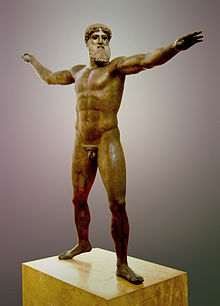
Original, with the following link you will get directly to the exhibit of the
National Archaeological Museum in Athens (in the last third, please scroll down to the illustrations):
Poseidon, Greek god of the sea and all waters (Roman Neptunus), son of Titan Kronos and his sister and wife Rhea, brother of Zeus and Hades,
husband of the Amphitrites, who gave birth to the Triton. Poseidon was the lord of earth depth, who caused earthquakes and storms with his trident. Especially in Boeotia and Arcadia he was highly revered as the god of the earthquake, which is why the poet Homer gave him the epithet "earth shaker".
He lived in the depths of the sea and appeared in large retinue of lower sea deities and animals. He built the walls of the city of Asia Minor for Laomedon, whose son Priam later ruled Troy.
Furious at the glare of his son Polyphemus, he persecuted Ulysses with his anger. Poseidon was often associated with bull or horse, he was considered the protector of fishing.
The Isthmic Games have been celebrated in honour of Poseidon since 582 BC. In the 2nd and 4th year of an Olympic Games, the Isthmic Games were held on the Isthmus of Corinth with sporting competitions and horse races, later also with musical competitions. The prize was a spruce wreath.
In art Poseidon was usually depicted naked and with a trident. The representation of Poseidon's dispute with Athena in the western gable of the Parthenon is famous. Numerous fountains have Poseidon sculptures.
The 2 m high bronze hollow casting statue was probably created by the early classical artist Kalamis around 450 BC. In 1928 it was found in the sea near Cape Artemision, in the north of the island of Euboea.
Exhibit of the Athens National Archaeological Museum, Inventory No. 15161 - bust-reproduction reduced.